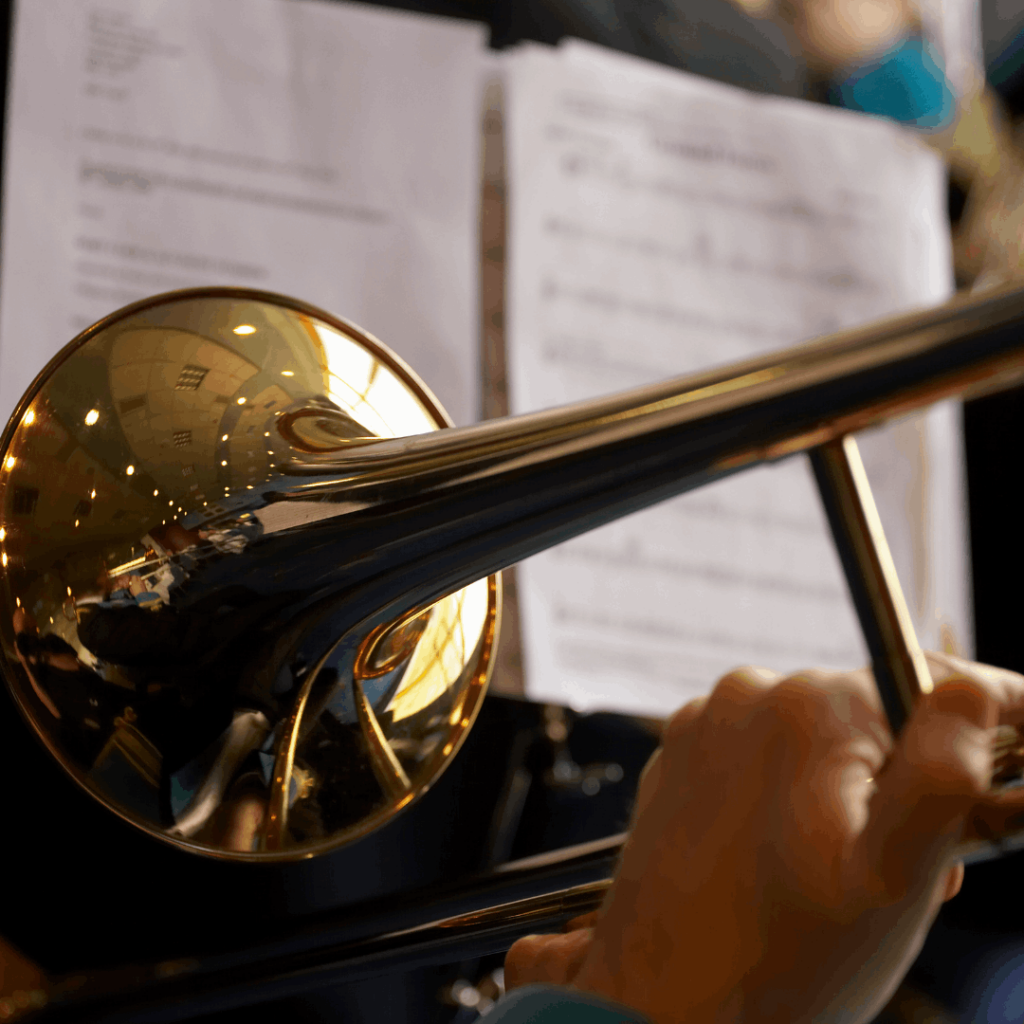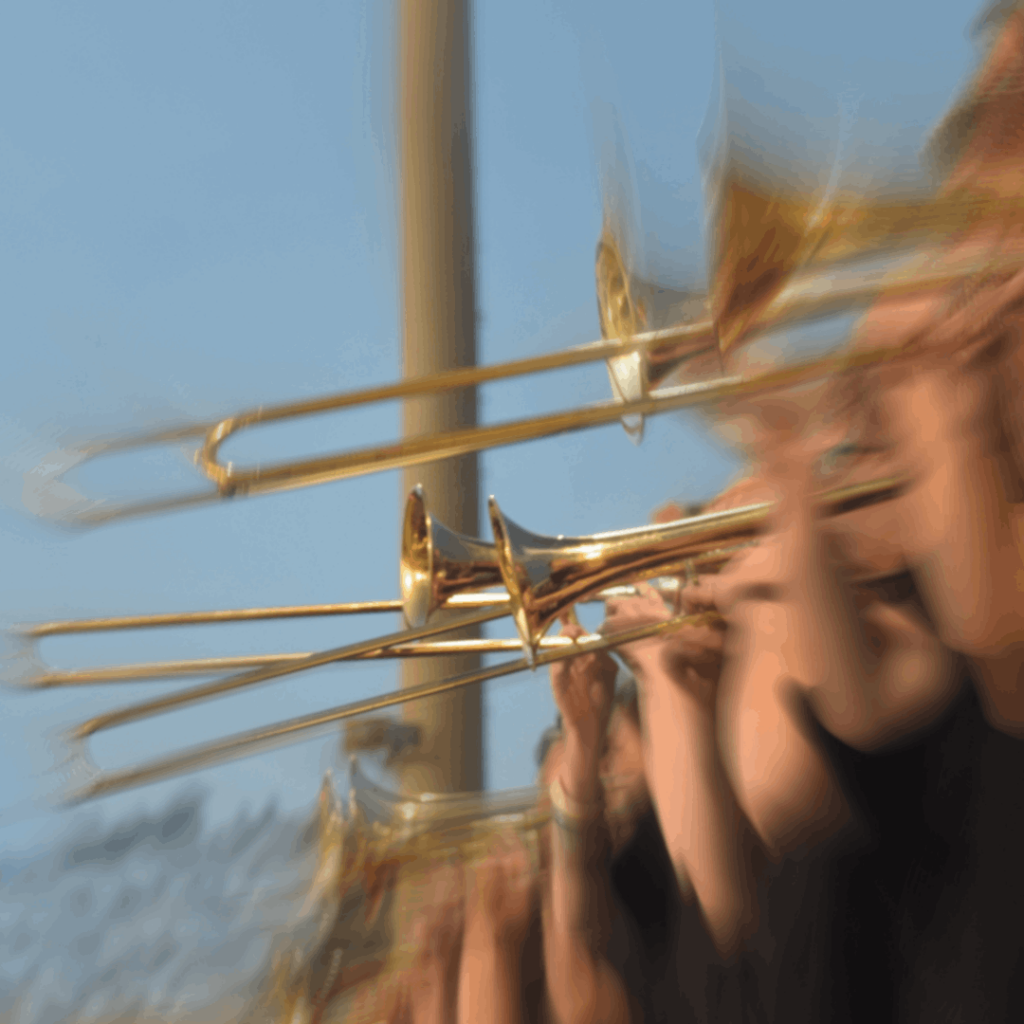Best
Standard Bb Tenor Trombone
-
Overall: Easy to play with an accurate and brilliant sound
-
Best Feature: With a yellow brass bell for warm and clear tones
-
TedScore™: 10/10
Best
Bass
Trombone
Trombone BUILT TO A PROFESSIONAL STANDARD
-
Overall: Excellent projection with a wide bore size
-
Best Feature: Perfectly smooth chrome-plated inner slides for effortless action
-
TedScore™: 9/10
Best
Alto
Trombone
Trombone EXCELLENT-QUALITY ALTO TROMBONE
-
Overall: Boasts perfectly smooth inner slide tubes
-
Best Feature: A large yellow-brass bell that gives excellent projection
-
TedScore™: 8.5/10
Slide into my office, fellow brass enthusiasts!
I’m your trombone-toting maestro, here to guide you through the slide-o-rama that is trombone playing.
I’ve serenaded audiences from jazz clubs to symphony halls, and it all started with mastering the slide.
No need to sweat it—my trusty trombone fingering chart is your golden ticket to musical glory. It’s the map I used to navigate my way to trombone triumph, and now it’s your turn.
Let’s get sliding!
Basics of Trombone Fingering

First, let’s start with the basics: the slide positions.
The trombone slide position is numbered from the first to the seventh, each corresponding to a different note. Here’s a quick breakdown by slide position:

To play a note, you must position the slide correctly. For example, you must place the slide in the second position to play a B-flat.
But how do you know where each position is? That’s where the trombone fingering chart comes in. This trombone fingering chart shows you the correct slide position for each note.
Some charts even include alternate fingerings for certain notes, which can be helpful in certain situations.
It’s important to note that the trombone is a transposing instrument, which means that the notes you play on the instrument sound different from the written notes.
For example, when you play a C on the trombone, it sounds like a B-flat. This can take some time, but you’ll learn to adjust your playing accordingly with practice.
Understanding the Trombone Fingering Chart
Reading the Chart
Identifying Notes and Positions
Tips for Using the Chart
Here are a few tips to help you learn to use the trombone fingering chart effectively:

Practice regularly to develop muscle memory and improve your ability to identify notes and positions.
Experiment with different slide positions to find the one that produces the best sound for a particular note or phrase.
Recommended Popular Types of Trombone
King 3B Bb Tenor Trombone

FEATURES: Easy to play with an accurate and brilliant sound
OTHER INFO: Finished with a bright clear lacquer for additional tonal warmth
- Famed for its excellent versatility
- Includes wood shell case and mouthpiece
- Not easy to find
When you click ‘Check Price’, you’ll see there are loads of great places to buy this item. Our personal favorite is Sweetwater for the US, and Thomann and Gear4Music for the UK & Europe.
They are the largest music retailers, with excellent customer service, competitive prices, really fast shipping, and the longest guarantees.
The professional musician who wrote this article combined many things,
from the product build, manufacturer’s reputation through to feedback
from other users, to create our famous TedScore™.
Conn 62HI Bass Trombone

FEATURES: Provides excellent projection with a wide bore size and rose brass bell
OTHER INFO: Delivers a wide range of tonal colours through the dynamic range
- Ideal for either symphony orchestras or brass groups
- Comes with a Conn mouthpiece and instrument case
- Higher price range compared to other models
When you click ‘Check Price’, you’ll see there are loads of great places to buy this item. Our personal favorite is Sweetwater for the US, and Thomann and Gear4Music for the UK & Europe.
They are the largest music retailers, with excellent customer service, competitive prices, really fast shipping, and the longest guarantees.
The professional musician who wrote this article combined many things,
from the product build, manufacturer’s reputation through to feedback
from other users, to create our famous TedScore™.
Conn 34H Alto Trombone

FEATURES: A large yellow-brass bell that gives excellent projection and tonal warmth
OTHER INFO: Boasts perfectly smooth inner slide tubes for effortless action and playability
- High-performance alto trombone
- Comes with a mouthpiece and instrument case
- A little pricey compared to other brands
When you click ‘Check Price’, you’ll see there are loads of great places to buy this item. Our personal favorite is Sweetwater for the US, and Thomann and Gear4Music for the UK & Europe.
They are the largest music retailers, with excellent customer service, competitive prices, really fast shipping, and the longest guarantees.
The professional musician who wrote this article combined many things,
from the product build, manufacturer’s reputation through to feedback
from other users, to create our famous TedScore™.
Trombone Fingering Chart
Summary
And there you have it, my slide-slinging compadres—the grand secret of trombone wizardry lies in the noble slide!
It’s this telescoping wonder, combined with my buzzing lips and mighty breath, that conjures the majestic sounds that have made trombones the heartthrobs of the brass world.
Let me tell you, a trombone fingering chart isn’t just helpful—it’s my sidekick, my Rosetta Stone, and yes, my trom-bone-a-fide lifesaver.
It’s the cheat sheet that helped me go from tooting in the garage to rocking the stage, hitting every note like I was born with a slide in my hand.
Whether you’re jazzing it up with your pals or marching to the beat of a drumline, this chart is your backstage pass to brass stardom.
So, grab that horn and chart, and let’s slide into musical infamy together!
Before you go…
If you’re a jazz enthusiast looking for the perfect brass instrument to play to spice up your music, make sure to check out this next article!
FAQ's
The 7 trombone positions are determined by the length of the tubing and the position of the slide. The trombone positions are numbered from first to seventh, with the first position being the shortest and the seventh position being the longest.















One aspect that might also be worth discussing is the impact of embouchure on achieving the correct pitch in each slide position. Particularly for beginners, understanding how slide position combines with embouchure to produce accurate notes can be a pivotal part of their learning curve.
lol imagine using a trombone slide as a lightsaber… trombone wars: the musician strikes back! 😛
Can I join the dark side too?
Darth Tromboner rises!
I must commend you, Rory, for such an enlightening article. The demystification of the trombone’s slide mechanics presents a substantial opportunity for beginners to advance in their craft with greater confidence. The mention of popular trombone models serves as an excellent guide for those looking to purchase their instrument. Well done.
hey, got a question, does the slide position change if you’re playing in a different key or it’s all the same? still figuring this stuff out. thanks, Terry
good question Terry, i was wondering the same!